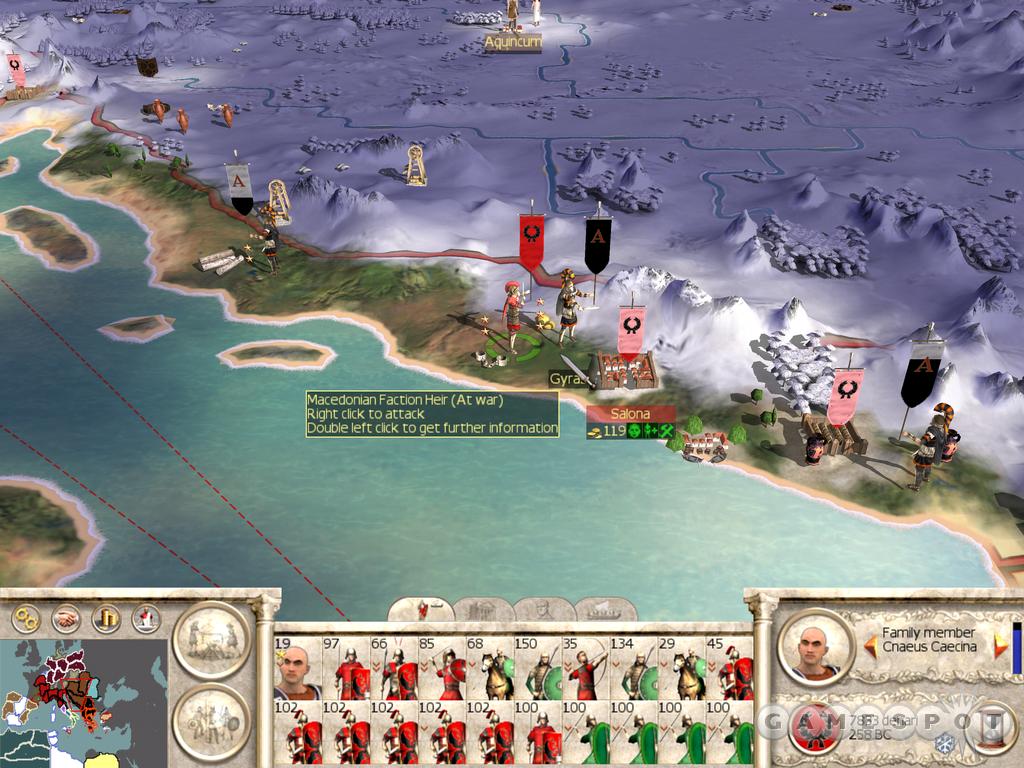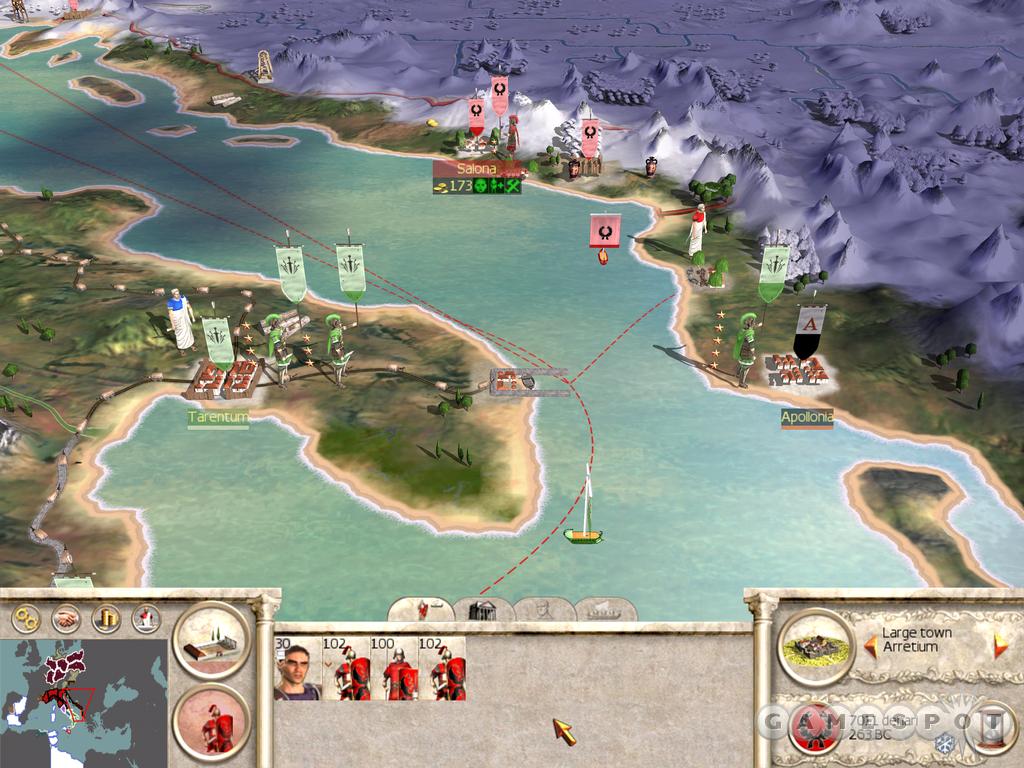Rome: Total War Designer Diary #4
Designer Mike Brunton walks us through the new 3D campaign map created for Rome: Total War and tells us how it's better than ever.
With Shogun: Total War and Medieval: Total War, the folks at Creative Assembly have amassed an impressive record for making strategy games that let you conquer whole regions of the historic world. The Total War games feature turn-based strategic gameplay that lets you move armies around the map and build your empire. And when armies meet, you can drop down to a 3D battlefield and command your forces in real time. Creative Assembly is now finishing up Rome: Total War, which is one of the most anticipated strategy games of the year. While the biggest new feature of Rome: Total War is the beautiful new 3D graphics engine that allows you to watch thousands of men battle it out among elephants, cavalry charges, and flaming pigs, the game features a new 3D campaign map, as well. And as writer and designer Mike Brunton explains, the new map will change the way you play Total War.

The Roman Empire in 3D
By Mike BruntonWriter/Designer, Creative Assembly
It's probably a good idea to have a look at one of the major changes in the way Rome: Total War works compared to the previous Total War titles--and that is the campaign map. Within a couple of seconds of playing Rome: Total War, you should notice that the whole world has changed. Your personal world, of course, will have changed immeasurably, and for the better. Larks will sing, bees will hum happily, and you'll wonder how you ever managed to play anything else. Oh, all right then--players of Medieval: Total War and Shogun: Total War will notice that the whole Rome: Total War campaign map is completely different from anything before. Out goes the flat map. Armies no longer march across borders into a province and fight whoever is there. In comes a 3D system with all the "lumpy bits" of hills, mountains, rivers, and forests. Armies now march across the gameworld and occupy one of the thousands of terrain tiles.
Every area on the 3D landscape (barring the impassable ones, such as mountains) can be a battlefield when armies clash. The cool bit is that the surrounding terrain is also visible from the battlefield as well--fight in the shadow of Vesuvius, and the home of Vulcan is there, smoking away quietly to itself! In the Rome: Total War 3D landscape, it's now quite clear what and where is defensible. You can quite clearly see where the mountain passes can be garrisoned and the river crossings guarded. It makes sense to build border forts and keep garrisons in them. You can even build the equivalent of Hadrian's Wall or the Rhine frontier forts if you want, but taxes will have to rise to pay for it all.
The 3D map has introduced an "operational" level of decision making into the game. Invasion is strategic; battle is tactical; deciding where the fight happens is operational. The results can be quite interesting no matter what you're doing. You can position armies in forests so that they can ambush foolish invaders. All of a sudden a frontier doesn't look like a line on the map; there are invasion routes that need watching in both directions and places that are worth fighting over because they control lines of communication. It's actually worth sending armies out to cut trade routes, for example. Conversely, large gangs of rebels, brigands, bandits, barbarians, and assorted smelly people will also take apparent delight in sitting right on top of your most profitable trade links and robbing you blind.
Back to the business of combat. As an invader, you now have to march over to the spot the enemy occupies and attacks. You now have to consider whether it's worth battering through a choke point or taking an indirect approach into enemy land. Simply marching into a province is no longer enough.
The battles and the campaign are intimately linked, of course. March your army into battle, and all the units that comprise that army will be on the field (as before in other Total War games). But with a change to 3D, we've been able to do a couple of new things about reinforcements and introduce options that clever players will be able to exploit to the full. Where you place your armies and who can join in a battle are now important factors. Friendly armies in close proximity to your attacking army can march toward the battle and appear as reinforcements. The cool bit is that they always appear on the battlefield from the right direction. Move your armies to the enemy's flank or rear, and you've got the start of a perfect pincer movement. On the battlefield, you lead an army that hammers forward while the supporting reinforcements sweep in to act as the anvil. Result: Pain and misery for the foe while your men get back to camp in time for the wine and burger cookout. (Bizarre, but true: Burgers were a Roman invention.) Of course, this isn't so much fun when the enemy takes on the roles of hammer and anvil.
Many of these comments also apply to sea movement as well. Fleets now carry armies across the waves, and there are places on the map where it's possible to be "ambushed" at sea. Sticking to the coasts is a good idea, especially when storms can carry off unsuspecting mariners! But sailing down the coast to descend upon an enemy's land may give him warning of what's afoot, or rather, afloat.

There are side benefits in the change to the 3D system created for Rome: Total War beyond the strategic aspects. For a start, the world looks handsome. Terrain looks like what you'd expect, and we even have a couple of volcanoes smoking away at Vesuvius and Etna. (Important hint: Do not stand near these during an eruption.) We can change the terrain over time so that roads and farmlands appear as they are developed around settlements (roads help your legions' mobility, of course). The settlements also change as fate is cruel or kind: Growth, conquest, and even enslavement are all reflected in the look of a settlement on the map. We've also made resources visible on the campaign map. You can see provinces and settlements with rich pickings before you invade. We can also show the passage of time by changing the gameworld according to the season: In winter, Germania looks a whole lot less inviting (particularly for troops who don't believe in warm underwear), covered as it is in a thick layer of snow. It's easy to see why, until quite recently, armies sensibly waited until the better weather came before going to war.
And on that cheery note, I'll leave it until next time to consider characters, families, and their "funny little ways."
Got a news tip or want to contact us directly? Email news@gamespot.com
Join the conversation